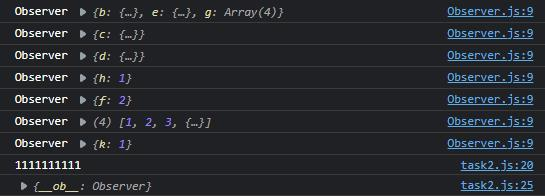1. 预期效果
当数据变动时,触发自定义的回调函数。
2. 思路
对对象 object 的 setter 进行设置,使 setter 在赋值之后执行回调函数 callback()。
3.细节
3.1 设置 setter 和 getter
JS提供了 [Object.defineProperty()](Object.defineProperty() - JavaScript | MDN (mozilla.org)) 这个API来定义对象属性的设置,这些设置就包括了 getter 和 setter。注意,在这些属性中,如果一个描述符同时拥有 value 或 writable 和 get 或 set 键,则会产生一个异常。
Object.defineProperty(obj, "key", {
enumerable: false, // 是否可枚举
configurable: false, // 是否可配置
writable: false, // 是否可写
value: "static"
});
我们可以利用JS的 [闭包](闭包 - JavaScript | MDN (mozilla.org)),给 getter 和 setter 创造一个共同的环境,来保存和操作数据 value 和 callback 。同时,还可以在 setter 中检测值的变化。
// task1.js
const defineReactive = function(data, key, value, cb) {
Object.defineProperty(data, key, {
enumerable: true,
configurable: true,
get() {
console.log('getter')
return value
},
set(newValue) {
if (newValue !== value) {
value = newValue
console.log('setter: value change')
cb(newValue)
}
}
});
}
const task = function() {
console.log('running task 1...')
const obj = {}
const callback = function(newVal) {
console.log('callback: new value is ' + newVal)
}
defineReactive(obj, 'a', 1, callback)
console.log(obj.a)
obj.a = 2
obj.a = 3
obj.a = 4
}
task()
至此我们监控了 value ,可以感知到它的变化并执行回调函数。

3.2 递归监听对象的值
上面的 defineRective() 在 value 为对象的时候,当修改深层键值,则无法响应到。因此通过循环递归的方法来对每一个键值赋予响应式。这里可以通过 observe() 和 Observer 类来实现这种递归:
// observe.js
import { Observer } from "./Observer.js"
// 为数据添加响应式特性
export default function(value) {
console.log('type of obj: ', typeof value)
if (typeof value !== 'object') {
// typeof 数组 = object
return
}
if (typeof value.__ob__ !== 'undefined') {
return value.__ob__
}
return new Observer(value)
}
// Observer.js
import { defineReactive } from './defineReactive.js'
import { def } from './util.js';
export class Observer {
constructor(obj) {
// 注意设置成不可枚举,不然会在walk()中循环调用
def(obj, '__ob__', this, false)
this.walk(obj)
}
walk(obj) {
for (const key in obj) {
defineReactive(obj, key)
}
}
}
在这里包装了一个 def() 函数,用于配置对象属性,把 __ob__ 属性设置成不可枚举,因为 __ob__ 类型指向自身,设置成不可枚举可以放置遍历对象时死循环
// util.js
export const def = function(obj, key, value, enumerable) {
Object.defineProperty(obj, key, {
value,
enumerable,
writable: true,
configurable: true
})
}
3.3 检测数组
从需求出发,对于响应式,我们对数组和对象的要求不同,对于对象,我们一般要求检测其成员的修改;对于数组,不仅要检测元素的修改,还要检测其增删(比如网页中的表格)
对由于数组没有 key ,所以不能通过 defineReactive() 来设置响应式,同时为了满足响应数组的增删改,所以 Vue 的方法是,通过包装 Array 的方法来实现响应式,当调用 push()、poll()、splice() 等方法时,会执行自己设置的响应式方法
使用 Object.create(obj) 方法可以 obj 对象为原型(prototype)创建一个对象,因此我们可以以数组原型 Array.prototype 为原型创建一个新的数组对象,在这个对象中响应式包装原来的 push()、pop()、splice()等数组
// array.js
import { def } from "./util.js"
export const arrayMethods = Object.create(Array.prototype)
const methodNameNeedChange = [
'pop',
'push',
'splice',
'shift',
'unshift',
'sort',
'reverse'
]
methodNameNeedChange.forEach(methodName => {
const original = Array.prototype[methodName]
def(arrayMethods, methodName, function() {
// 响应式处理
console.log('call ' + methodName)
const res = original.apply(this, arguments)
const args = [...arguments]
let inserted = []
const ob = this.__ob__
switch (methodName) {
case 'push':
case 'unshift':
inserted = args
case 'splice':
inserted = args.slice(2)
}
ob.observeArray(inserted)
return res
})
})
// Observer.js
import { arrayMethods } from './array.js'
import { defineReactive } from './defineReactive.js'
import observe from './observe.js'
import { def } from './util.js'
export class Observer {
constructor(obj) {
console.log('Observer', obj)
// 注意设置成不可枚举,不然会在walk()中循环调用
def(obj, '__ob__', this, false)
if (Array.isArray(obj)) {
// 将数组方法设置为响应式
Object.setPrototypeOf(obj, arrayMethods)
this.observeArray(obj)
} else {
this.walk(obj)
}
}
// 遍历对象成员并设置为响应式
walk(obj) {
for (const key in obj) {
defineReactive(obj, key)
}
}
// 遍历数组成员并设置为响应式
observeArray(arr) {
for (let i = 0, l = arr.length; i < l; i++) {
observe(arr[i])
}
}
}
3.5 Watcher 和 Dep 类
设置多个观察者检测同一个数据
// Dep.js
var uid = 0
export default class Dep {
constructor() {
this.id = uid++
// console.log('construct Dep ' + this.id)
this.subs = []
}
addSub(sub) {
this.subs.push(sub)
}
depend() {
if (Dep.target) {
if (this.subs.some((sub) => { sub.id === Dep.target.id })) {
return
}
this.addSub(Dep.target)
}
}
notify() {
const s = this.subs.slice();
for (let i = 0, l = s.length; i < l; i++) {
s[i].update()
}
}
}
// Watcher.js
import Dep from "./Dep.js"
var uid = 0
export default class Watcher {
constructor(target, expression, callback) {
this.id = uid++
this.target = target
this.getter = parsePath(expression)
this.callback = callback
this.value = this.get()
}
get() {
Dep.target = this
const obj = this.target
let value
try {
value = this.getter(obj)
} finally {
Dep.target = null
}
return value
}
update() {
this.run()
}
run() {
this.getAndInvoke(this.callback)
}
getAndInvoke(cb) {
const obj = this.target
const newValue = this.get()
if (this.value !== newValue || typeof newValue === 'object') {
const oldValue = this.value
this.value = newValue
cb.call(obj, newValue, newValue, oldValue)
}
}
}
function parsePath(str) {
var segments = str.split('.');
return (obj) => {
for (let i = 0; i < segments.length; i++) {
if (!obj) return;
obj = obj[segments[i]]
}
return obj;
};
}
// task2.js
import observe from "../observe.js";
import Watcher from "../Watcher.js";
const task2 = function() {
const a = {
b: {
c: {
d: {
h: 1
}
}
},
e: {
f: 2
},
g: [ 1, 2, 3, { k: 1 }]
}
const ob_a = observe(a)
const w_a = new Watcher(a, 'b.c.d.h', (val) => {
console.log('1111111111')
})
a.b.c.d.h = 10
a.b.c.d.h = 10
console.log(a)
}
task2()
执行结果如下,可以看到成功响应了数据变化
